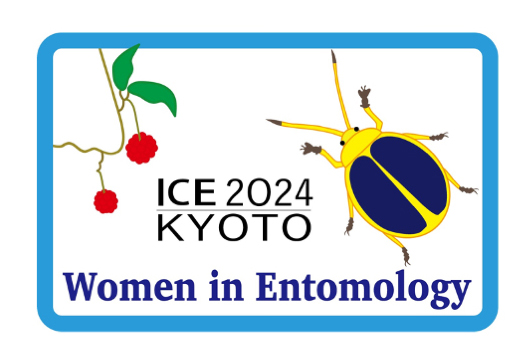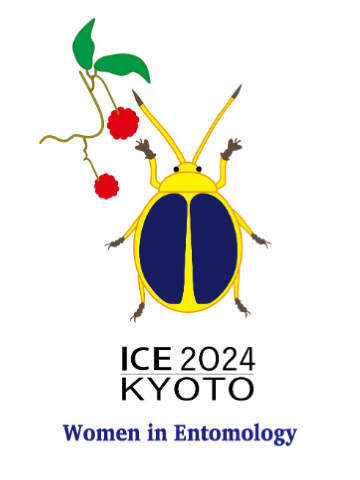


Oides bowringii with beautiful blue elytra is a rare insect found only in Kyoto and Hyogo Prefectures in Japan. Due to parthenogenesis, males have not been found in Japan.
青い前翅が美しいキベリハムシは、日本では京都府と兵庫県にのみ生息する珍しい昆虫です。単為生殖のため、日本では雄は見つかっていません。
Kadsura japonica is the main host of Oides bowringii. It has been loved by the Japanese since ancient times and has been written in waka poems.
“Meeting again” and “opportunities” are the flower language of Kadsura japonica.
ビナンカズラはキベリハムシの主食です。 古くから日本人に愛され、和歌にも詠まれてきました。「再会」「縁」はサネカズラの花言葉です。
We shall convene a luncheon seminar tailored for the participants of ICE2024, followed by a lecture coupled with a comprehensive panel discussion that extends an invitation not only to our attendees but also to the citizens at large.
ICE2024参加者向けのランチョンセミナーの開催や、市民向けプログラムとして講演会を行います。是非ご参加ください。
| Date & Time / 日時 | August 27 (Tue), 2024, 12:00PM-1:15PM / 2024年8月27日(火)12:00-13:15 |
|---|---|
| Venue / 会場 | Room E |
Free lunch box for first 190 people / 先着190名様にお弁当を提供いたします
Chair: Chizu Sanjoba

Akihisa Setoguchi 瀬戸口明久
Associate Professor, Institute for Research in Humanities, Kyoto University
京都大学人文科学研究所 准教授
Insect Collecting for Boys: Natural History and Gender in Japanese Popular Culture
Insect collecting is often regarded as a hobby among boys in contemporary Japan. This presentation will describe its origin in the natural history movement in twentieth-century popular culture. Insect collecting became popular in the early twentieth century, when juvenile magazines encouraged young readers to collect insects. In the 1930s, the study of natural history became an extensive popular movement, resulting in the establishment of many amateur naturalist societies. For example, Godō Nakanishi established the Nihon Yachō no kai (Wild Bird Society of Japan) in 1934, and Masayo Katō organized the Konchū shumi no kai (Insect Hobby Society) in 1932. Although there were many female members of the Wild Bird Society, there were very few girls in Katō’s Insect Hobby Society. This presentation will argue that the social context surrounding science made a significant difference in the gender balance among hobbyists of different varieties of natural history.
| Date & Time / 日時 | August 28 (Wed), 2024, 2:00PM-3:30PM / 2024年8月28日(水)14:00-15:30 |
|---|---|
| Venue / 会場 | Main Hall / メインホール |
Lectures are delivered in English and Japanese simultaneously. / 講演は英語と日本語に同時通訳されます。
Women Researchers in Science and Entomology
According to data from the UNESCO Institute for Statistics, women account for less than 30% of researchers worldwide. Moreover, the proportion of female researchers in East Asian countries such as Japan and South Korea is notably low on a global scale. In order to reexamine the issues related to gender imbalance in academia, this session aims to shed light on the challenges. It will also introduce initiatives in East Asia and share the perspectives of young researchers from around the world. Through a panel discussion, the goal is to enhance the visibility of female researchers in the International Entomological Congress and encourage the development of a more balanced and inclusive academic landscape in the future.
「サイエンス・昆虫学における女性研究者」
ユネスコ統計研究所のデータによると、世界の研究者に占める女性の割合は30%に満たないと言われています。さらに、日本や韓国など東アジアの女性研究者の割合は、世界的に見ても著しく低い数値です。本セッションでは、アカデミアにおけるジェンダー・アンバランスの問題を考え、課題を共有します。また、東アジア特に日本における取り組みを紹介し、世界の若手研究者の視点を共有したいと思います。パネルディスカッションを通じて、国際昆虫学会議における女性研究者の認知度を高め、将来的によりバランスの取れた包括的なアカデミアの発展を促すことを目指します。

Charlotte L. R. Payne Senior Editor and Team Leader (Magazine), Nature Human Behaviour, Nature Research
The Time for Women in Science
Women - and particularly women from minoritized groups - are underrepresented in global science. This must change, and the time is now. Globally, we’re working fiercely towards SDG5 (gender equality), and determined to address the setbacks of the COVID-19 pandemic. Institutions have more resources and commitment towards diversity, equity and inclusion than ever before. But what about individuals? Women’s life cycles are socially and culturally shaped. Stereotypes and misogyny are common and pervasive. For many women, time is a scarce resource. If we seriously want to promote, support and keep women in science, we need to be mindful of time and timing.

「サイエンスにおける女性の時代」
女性 - 特に少数派のグループに属する女性 - は、世界の科学分野で過小評価されています。この状況を変える必要があり、今がその時です。私たちは、SDG5(ジェンダー平等)に向けて精力的に取り組んでおり、COVID-19パンデミックにより生じた停滞に対処する決意をしています。多くの機関は、これまで以上に多様性、平等性、包括性に対するリソースを持ち、コミットメントを示しています。しかし、個人についてはどうでしょうか?女性のライフサイクルは社会的および文化的に形成されています。ステレオタイプや女性嫌悪は一般的であり、蔓延しています。多くの女性にとって、時間は貴重な資源です。科学分野での女性の活躍を真剣に促進し、支援・維持するのであれば、時間とタイミングに配慮する必要があるでしょう。

Gabriela Caballero
Postdoctoral researcher, The Sorbonne University
Member of the association for "Women in Sciences" in Paris, France
Bridging the Gap: Women in STEM in France
The under-representation of women in the STEM professions is a major problem. It deprives industry and academia of some potential talents needed to meet unprecedented challenges in the fields of environment, climate, and energy.
In France, women only account for 30% of researchers. Stereotypes, unattractive careers, sexual and gender-based violence, and the "glass ceiling" effect are today well-identified obstacles to the inclusivity of science and engineering, both in France and internationally, even if their relative importance may vary according to fields of study and regions of the world. To counter the effects of these obstacles, effective initiatives exist and deserve to be supported, if not generalized.
「ギャップを埋める:フランスにおけるSTEM分野の女性」
科学・技術・工学・数学(STEM)分野の専門職における女性の少なさは大きな問題です。産業界やアカデミアは、環境、気候、エネルギーの分野で前例のない課題に対処するために必要な潜在的な人材を奪っています。フランスでは、研究者に占める女性の割合は30%に過ぎません。ステレオタイプ、魅力のないキャリア、性的・ジェンダーに基づく暴力、そして "glass ceiling"(目では見えない障壁)効果は、研究分野や国や地域によって相対的な重要性が異なるとしても、フランスおよび国際的において、科学と工学の包括性に対する障害として今日よく認識されています。これらの障害の影響を打ち消すために、もし普及していないなら、効果的なイニシアチブを存続させ支援すべきです。

Yoshie Harada 原田慶恵
Professor, Institute for Protein Research, Osaka University
大阪大学 蛋白質研究所 教授
Women Researchers Paving the Way for Japan’s Future
In 2021, the percentage of female researchers in Japan was 17.5%, the lowest among OECD member countries. However, while male researchers are predominantly employed by private companies, a significant number of female researchers are affiliated with universities and public institutions, where their representation stands at a respectable 27.5%. Recently, many universities have been actively recruiting female researchers and promoting them to higher positions. These efforts have sparked diverse opinions. Nonetheless, I am confident that the increase in female researchers will broaden opportunities for collaborative research between male and female researchers. This collaboration will allow each to fully utilize their abilities, achieve results together, and pave the way for a future where both can thrive.

「日本の未来を担う女性研究者」
2021年における日本の女性研究者の割合は17.5%です。残念なことにOECD加盟国中で最も低い割合です。ただし、男性研究者が主に企業に所属しているのに対し、女性研究者は大学や公的機関に多数在籍しており、そこでの女性研究者の比率は27.5%と決して低くありません。最近では、多くの大学で女性研究者の積極的な採用に力を入れ、また、女性研究者を上位職に登用する動きが見られます。これらの取り組みには、さまざまな意見があります。しかし、女性研究者の増加によって、男女の研究者が協力して研究を推進する機会が広がることは、それぞれが自身の能力を存分に発揮し、共に成果を挙げ、活躍する未来への道を拓くと確信します。
| Chair / 座長 |
Masanobu Itoh 伊藤 雅信 |
|---|---|
| Facilitator / ファシリテーター |
Takahiro Shiotsuki 塩月孝博 |
| Panellists / パネリスト |
Charlotte L. R. Payne Gabriela Caballero Yoshie Harada 原田慶恵 |
The registration is already closed.
Registration
The registration site above is for the public who wish to attend this program.
Please note that ICE2024 participants do not have to register in advance.
By continuing to browse this website, you accept cookies which are used to offer a personalized experience on our website, generate statistics and realize advertising or social network tracking. Find out more about Cookie policy.
You can change your cookie settings at any time.
From 23 December to 4 January(Japan time)
The Management Office will be on holiday
We will reply after 5 January (JST) in turn.